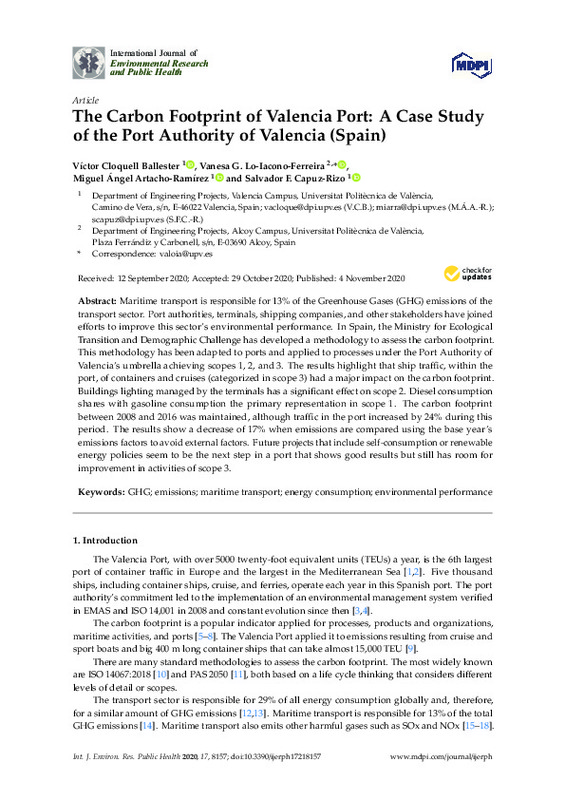Visor Cartográfic de la Generalitat http://visor.gva.es/visor/
Eurostat https://appsso.eurostat.ec.europa.eu/nui/submitViewTableAction.do
EMAS Register https://webgate.ec.europa.eu/emas2/public/registration/list
[+]
Visor Cartográfic de la Generalitat http://visor.gva.es/visor/
Eurostat https://appsso.eurostat.ec.europa.eu/nui/submitViewTableAction.do
EMAS Register https://webgate.ec.europa.eu/emas2/public/registration/list
Environmental Statement 2018 https://www.valenciaport.com/wp-content/uploads/Memoria-Ambiental-2018ENG.pdf
Li, Y., Wang, Y., He, Q., & Yang, Y. (2020). Calculation and Evaluation of Carbon Footprint in Mulberry Production: A Case of Haining in China. International Journal of Environmental Research and Public Health, 17(4), 1339. doi:10.3390/ijerph17041339
2019 Status Report. The Task Force on Climate-Related Financial Disclosures https://www.fsb-tcfd.org/publications/tcfd-2019-status-report/
Jalkanen, J.-P., Johansson, L., & Kukkonen, J. (2016). A comprehensive inventory of ship traffic exhaust emissions in the European sea areas in 2011. Atmospheric Chemistry and Physics, 16(1), 71-84. doi:10.5194/acp-16-71-2016
Carballo-Penela, A., Mateo-Mantecón, I., Doménech, J. L., & Coto-Millán, P. (2012). From the motorways of the sea to the green corridors’ carbon footprint: the case of a port in Spain. Journal of Environmental Planning and Management, 55(6), 765-782. doi:10.1080/09640568.2011.627422
International Standard Organization ISO 14067:2018 Greenhouse Gases—Carbon Footprint of Products—Requirements and Guidelines for Quantification https://www.iso.org/standard/71206.html
PAS 2050:2011: Specification for the Assessment of the Life Cycle Greenhouse Gas; Emissions of Goods and Services https://shop.bsigroup.com/upload/shop/download/pas/pas2050.pdf
Schmalensee, R., Stoker, T. M., & Judson, R. A. (1998). World Carbon Dioxide Emissions: 1950–2050. Review of Economics and Statistics, 80(1), 15-27. doi:10.1162/003465398557294
DORE, A., VIENO, M., TANG, Y., DRAGOSITS, U., DOSIO, A., WESTON, K., & SUTTON, M. (2007). Modelling the atmospheric transport and deposition of sulphur and nitrogen over the United Kingdom and assessment of the influence of SO2 emissions from international shipping. Atmospheric Environment, 41(11), 2355-2367. doi:10.1016/j.atmosenv.2006.11.013
Doudnikoff, M., & Lacoste, R. (2014). Effect of a speed reduction of containerships in response to higher energy costs in Sulphur Emission Control Areas. Transportation Research Part D: Transport and Environment, 27, 19-29. doi:10.1016/j.trd.2013.12.008
(2011). Environmental Impacts of International Shipping. doi:10.1787/9789264097339-en
Hongisto, M. (2014). Impact of the emissions of international sea traffic on airborne deposition to the Baltic Sea and concentrations at the coastline⁎⁎The research has received funding from the European Regional Development Fund, Central Baltic INTERREG IV A programme within the SNOOP project. Oceanologia, 56(2), 349-372. doi:10.5697/oc.56-2.349
Lee, P. T. ‐W., Hu, K., & Chen, T. (2010). External Costs of Domestic Container Transportation: Short‐Sea Shipping versus Trucking in Taiwan. Transport Reviews, 30(3), 315-335. doi:10.1080/01441640903010120
Medda, F., & Trujillo, L. (2010). Short-sea shipping: an analysis of its determinants. Maritime Policy & Management, 37(3), 285-303. doi:10.1080/03088831003700678
Carbon Emissions Study in the European Straits of the PASSAGE Project https://www.interregeurope.eu/fileadmin/user_upload/tx_tevprojects/library/file_1528203599.pdf
Carbon Footprint of Container Terminal Port in Mumbai; International Conference on Impact of climate change on Food, Energy and Environment. Elsevier https://www.researchgate.net/publication/269702576_Carbon_Footprinting_of_Container_Terminal_Ports_in_Mumbai
Jurong Port. Carbon Footprint Report 2010 https://esi.nus.edu.sg/publications/esi-publications/publication/2015/12/18/jurong-port-carbon-footprint-report-2010
Tool to Assess Global Warming at Port Facilities https://www.portoflosageneles.org/references/news_112911_calculator
Carbon Footprint a Key in Port Sustainability. CIP 2017. 14–15 https://issuu.com/revistacip3/docs/revista_cip_06_octubre_2017
Mamatok, Y., Huang, Y., Jin, C., & Cheng, X. (2019). A System Dynamics Model for CO2 Mitigation Strategies at a Container Seaport. Sustainability, 11(10), 2806. doi:10.3390/su11102806
Azarkamand, S., Wooldridge, C., & Darbra, R. M. (2020). Review of Initiatives and Methodologies to Reduce CO2 Emissions and Climate Change Effects in Ports. International Journal of Environmental Research and Public Health, 17(11), 3858. doi:10.3390/ijerph17113858
Guía de Cálculo Guía Para el Cálculo y Gestión de la Huella de Carbono en Instalaciones Portuarias Por Niveles https://www.valenciaport.com/wp-content/uploads/guia-calculo-gestion-huella-carbono.pdf
Memoria Verificación Gases Efecto Invernadero. Puerto de Valencia; Valencia. Year 2008–2016 https://www.valenciaport.com/en/publicaciones/
Ministry for Ecological Transition and Demographic Challenge https://www.miteco.gob.es/en/ministerio/default.aspxhttps://www.miteco.gob.es/es/cambio-climatico/temas/mitigacion-politicas-y-medidas/instruccionescalculadorahc_tcm30-485627.pdf
Real Decreto 163/2014, de 14 de Marzo, por el que se Crea el Registro de Huella de Carbono, Compensación y Proyectos de Absorción de Dióxido de Carbono https://www.boe.es/diario_boe/txt.php?id=BOE-A-2014-3379
2006 IPCC Guidelines for National Greenhouse Gas Inventories. Japan: N. p., 2006 https://www.ipcc-nggip.iges.or.jp/public/2006gl/
Cloquell-Ballester, V., Lo-Iacono-Ferreira, V. G., Artacho-Ramírez, M. Á., & Capuz-Rizo, S. F. (2020). RUE Index as a Tool to Improve the Energy Intensity of Container Terminals—Case Study at Port of Valencia. Energies, 13(10), 2556. doi:10.3390/en13102556
[-]









